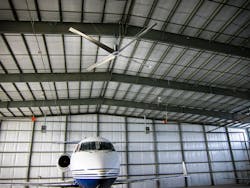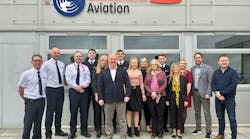Airplane hangars are tall, cavernous structures. While that’s great for storing multiple aircraft inside them, these unique designs lead to several facility management challenges. Energy costs, temperature control, air quality and safety/comfort issues can all arise in this environment.
In an effort to mitigate these challenges, more and more hangar owners are installing high-volume, low-speed (HVLS) fans. HVLS fans can significantly improve the comfort and health of pilots, guests and mechanics. On top of that, they can save building operators substantial amounts of money by making existing heating and ventilation systems more efficient, while providing additional benefits in buildings with no air conditioning.
HVLS versus other types of fans
High-speed ceiling or floor fans can help increase air movement, but they have several disadvantages when compared to HVLS ceiling fans. HVLS fans can move larger volumes of air with a single fan covering an area up to 22,000 square feet. In fact, a single HVLS fan can replace as many as 10 to 20 floor fans, without any of the clutter caused by electrical cords on the ground.
HVLS fans consume less energy than traditional, high-speed ceiling or floor fans and even produce less noise. New direct drive, gearless motors are available in some HVLS fan models that negate noise even more, which can be beneficial to aviators and mechanics who need to hear engines and props clearly while working on aircraft in the hangar. These types of gearless motor fans don’t use oil, so there’s no fear of a drip that might compromise aircraft or interfere with operations.
HVLS Complements HVAC
The long blades (up to 24-foot diameter) of HVLS fans spin much more slowly than a traditional ceiling or floor fan. Their unique blades are specially designed to capture the maximum amount of air and push it softly to the floor.
In the summer, the gentle breezes created by an HVLS fan keep employees and visitors cool by quickening the evaporation of sweat. In winter, in a process called destratification, the fans take the warm air created by an HVAC system and pull it down from the ceiling to the floor level, allowing people inside to be more comfortable with a lower thermostat setting.
Energy Savings Add Up
A 24-foot diameter model uses 1,500 watts per hour for cooling and as little as 100 watts for destratification, making HVLS fans extremely energy efficient. This translates to operating costs of as little as a few cents per hour. During the winter months, HVLS fans can reduce energy consumption by up to 30 percent.
When used to supplement air conditioning, the fans help lower the perceived temperature – which means thermostat set-points can be raised. Because energy costs are reduced roughly 4 percent for every degree the set-point is raised, a 3- to 4-degree increase in the set-point can reduce energy consumption by 12 to 16 percent. With year-round use, HVLS fans can pay for themselves in as little as 6 months.
Advantages of HVLS in Hangars
Many advantages of HVLS fans are even more pronounced in airplane hangars due to the way they are constructed and the material they are made from.
Most hangars are made from metal, are several stories tall and are one big, wide-open space. A higher ceiling coupled with a large, open area usually leads to temperature inconsistencies throughout a building. HVLS fans are capable of covering a large area and those benefits are only more pronounced in taller buildings, as the air it pushes toward the ground only widens in a conical shape. The fact that metal conducts heat extremely well only adds to the need for the benefits that HVLS fans provide – primarily a light, cooling breeze.
One not-so-obvious advantage of HVLS fans is that they deter birds from flying into and nesting in hangars, even when they are open to the outdoor elements.
Controlling SSS and SBS
HVLS fans can even aid in mitigating a health and safety issue – sweating slab syndrome (SSS) and sick building syndrome (SBS).
SSS occurs when moisture intermittently develops on the surface of an interior concrete slab. These increases slipperiness of the concrete surface and poses a serious risk to people who walk on it. When warm, humid air enters the structure through open doorways, windows, and vents, it will condense on any surface that is at or below dew point temperature – often the floor surface. This often occurs in spring when cool evenings are followed by warm mornings. HVLS ceiling fans can help reduce or eliminate slab sweating by minimizing ceiling-to-floor temperature differentials and increasing the surface evaporation rate.
SBS is used to describe what happens to building occupants who experience acute health issues. Most affected people have clinically identifiable symptoms (such as headache, dizziness, nausea) and typically feel better soon after leaving the building. Increasing ventilation rates and air distribution through means like HVLS fans often can be a cost-effective means of providing additional air flow, while also reducing indoor pollutant levels that can build up in ventilation systems.
Getting the Right Spin
Hangars are notoriously difficult structures to maintain temperature and comfort levels. However, the right type of HVLS fan can provide uniform air temperatures from ceiling to floor in an energy-efficient manner. Not to mention, improved air quality and a gentle breeze make the entire experience more enjoyable for anyone inside the structure.
Andy Olson is the director of marketing for Rite-Hite Fans. Rite-Hite is a manufacturer of loading dock equipment, industrial doors, safety barriers, HVLS fans, industrial curtain walls, and more, all designed to improve safety, security, productivity, energy consumption, and environmental control. For more information, visit www.ritehite.co





